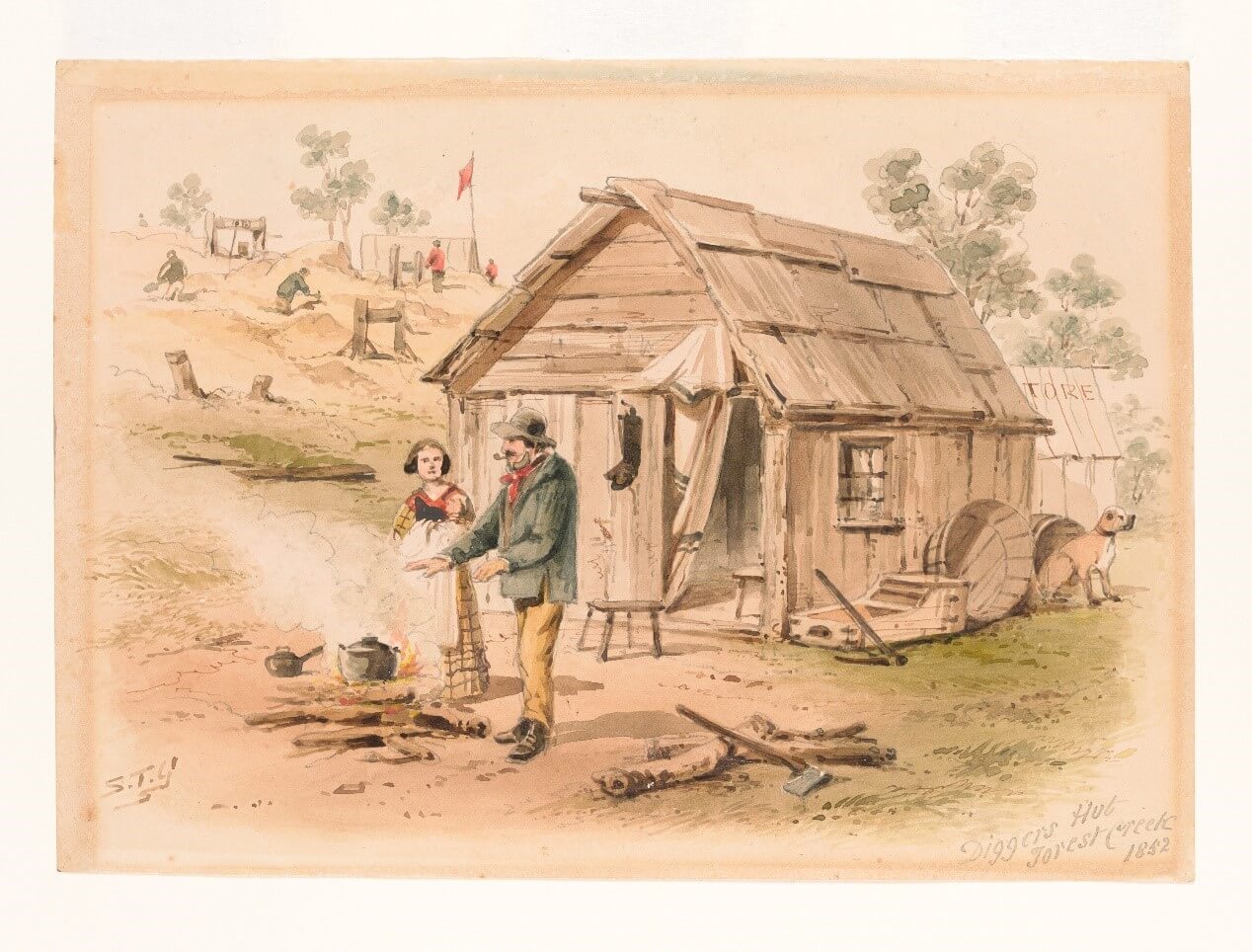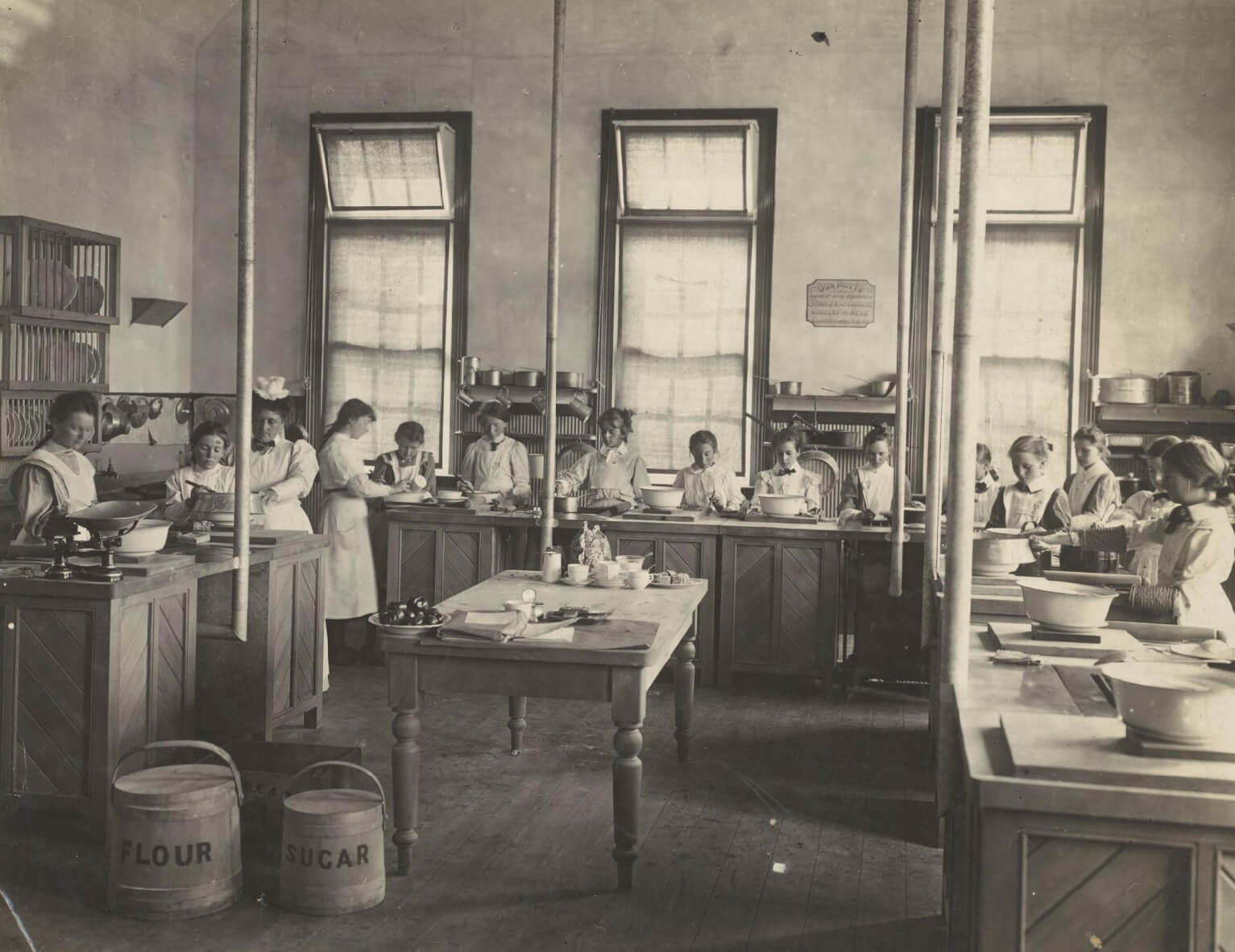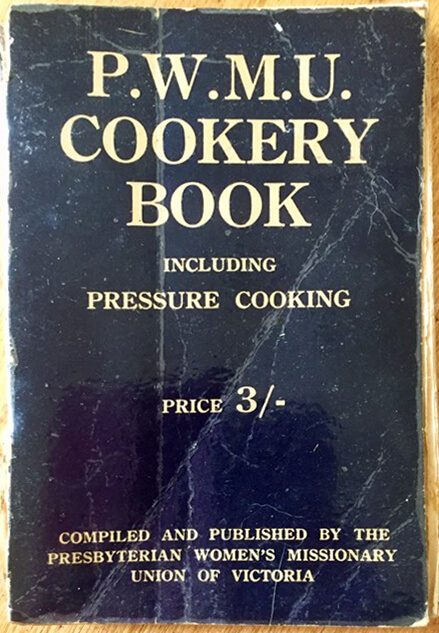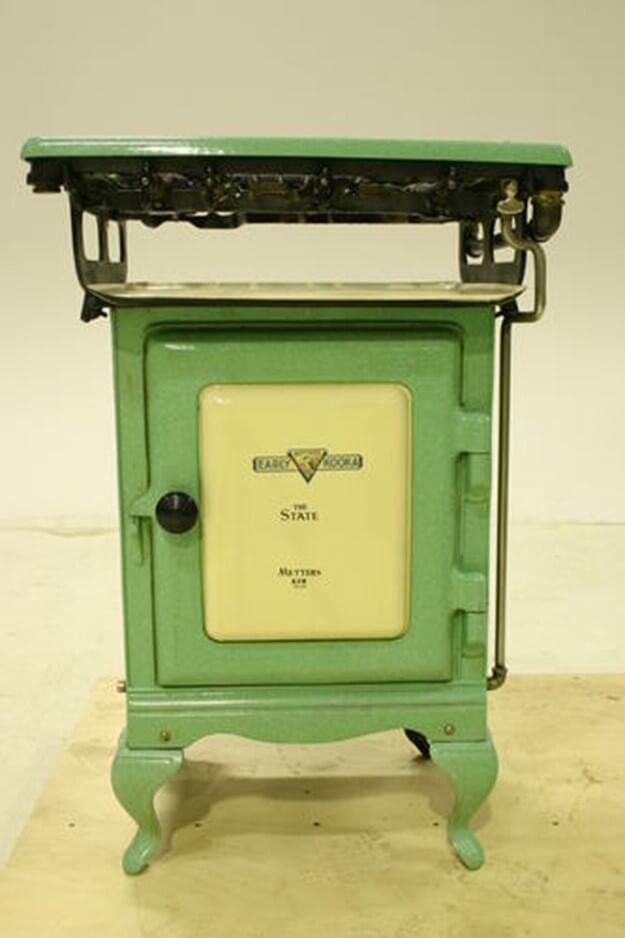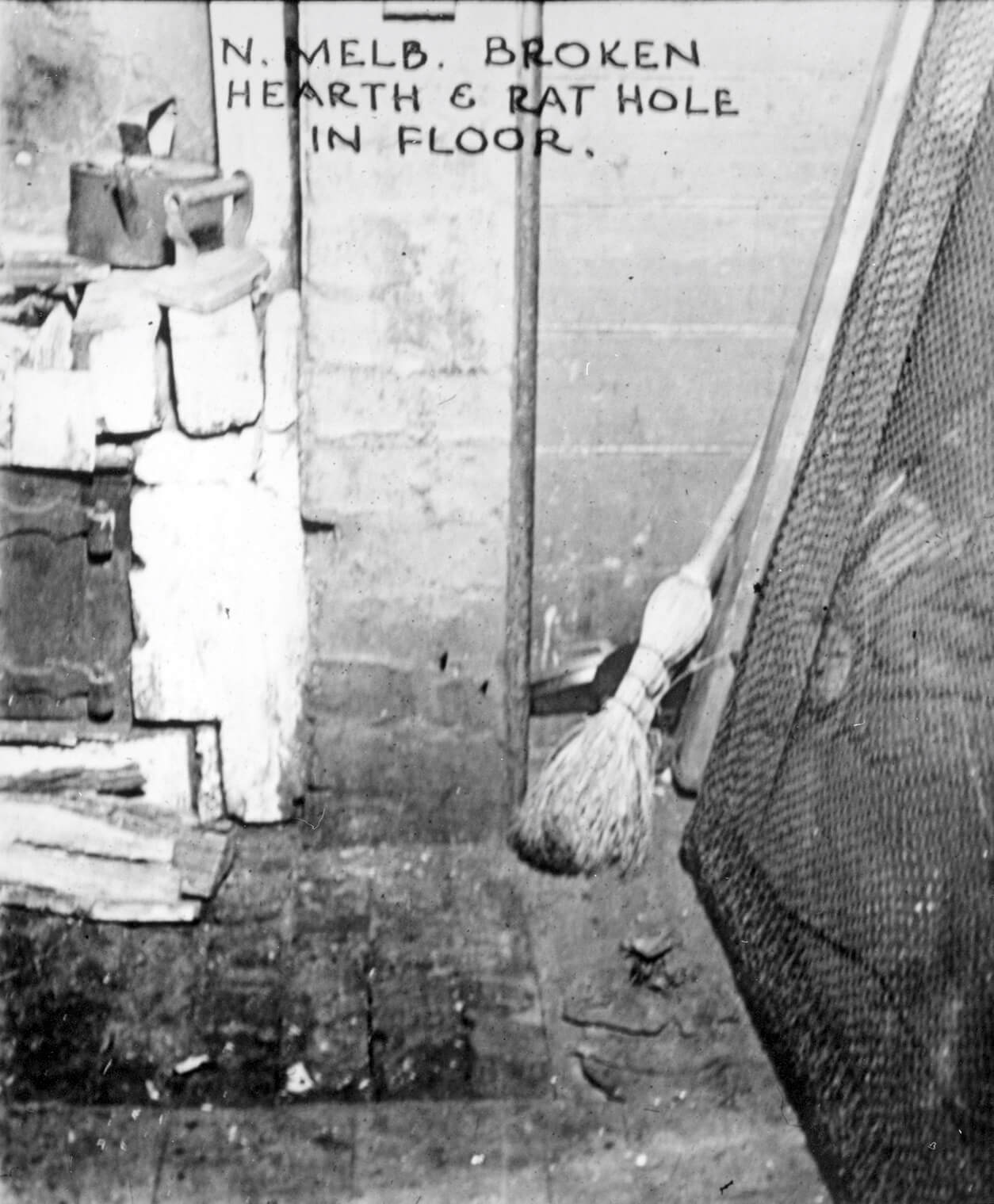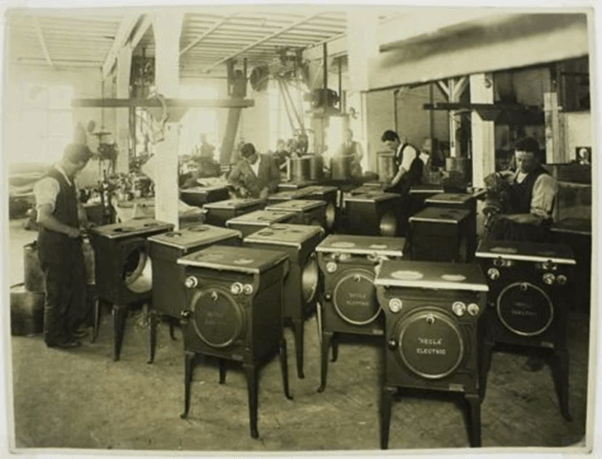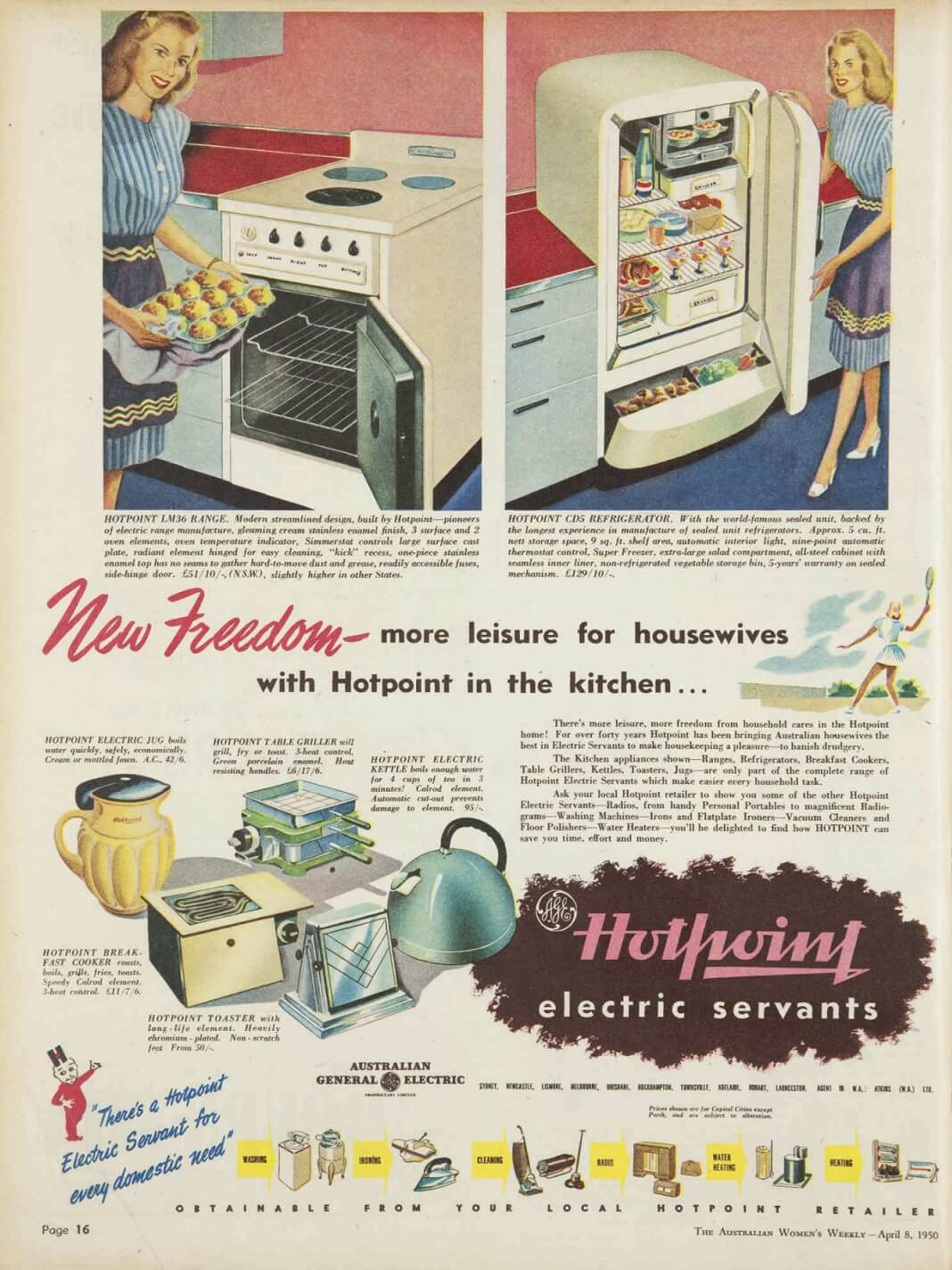At first cooking in Victoria was a makeshift affair, with pots often suspended over open fires outside, while covered, cast iron pots known as ‘dutch ovens’ could be placed on hot coals. This form of cooking was common in the first years of Melbourne, and on the gold fields during the 1850s, when camps were transient and few went to the trouble of building a kitchen. Baking traditional yeast-leavened bread was very difficult in these conditions, but varieties of ‘damper’, a form of soda bread made with flour, salt, water (or milk and butter if available) and baking soda, was much more common. Of course, women had first to build their fires and keep them burning – no mean feat if it rained! Children were often deputized to find wood and kindling.
S T Gill, ‘Digger’s Hut, Forest Creek, 1852’
Reproduced courtesy State Library Victoria
Although this digger’s wife has a rough wooden hut rather than a tent, she still has only a fire on the ground in front of the hut for cooking. A Dutch oven can be seen placed on the fire, while a long-handled pan with a lid lies alongside. The wood chopping ‘block’ is a tree trunk.
In the towns cooking on wood or coal-fired stoves was common until the late-nineteenth century, and well after this in poorer districts. The first stoves were open ranges, with pots suspended over open fires, sometimes with small, closed ovens on the side. These stoves made kitchens hot and smoky and fire was an ever-present danger. The closed range was a great improvement, and it gradually replaced the open range from the mid-nineteenth century. A far greater variety of cooking was possible on the closed range, but still many households could not bake their own bread or manage the weekly roast. This was commonly taken to a near-by baker to cook for a small fee.
Cooking on a wood-fired stove required skill and planning. The first job of the day was usually re-kindling the kitchen fire, which was commonly ‘banked-up’ overnight. Nothing could be done until the fire heated the stove tops, which took some time. A large kettle of water was usually then left simmering on the stove, ready for tea, cooking water and washing water. Even making a cup of tea required forethought. If you have ever tried to heat a kettle of cold water on a wood-fired stove top, you will know that it takes a long time to come to the boil. The electric jug or kettle must have seemed miraculous!
The temperature of early ovens was not regulated, except by adding fuel, or allowing the ovens to cool. Nor was there a temperature gauge, which meant that early cooks had to learn to judge the heat of the oven by feel. Dishes requiring the hottest oven, like bread or scones, were then cooked first, with other dishes replacing them as the oven cooled. Slow-cooked dishes, like milk puddings, were generally cooked last. Skill and judgement were acquired over time, and girls often learned to cook from their mothers, beginning with simple dishes when quite young. Domestic skills were also taught at school, especially as girls began to stay there longer. It was assumed that even girls who continued their education at a secondary school (a minority until the 1920s,) would take charge of a household eventually, and should understand the basics of ‘scientific’ household management. Girls learned cookery and other household skills, while boys were taught woodwork and sometimes metalwork. This form of gendered curriculum remained in place until the late twentieth century.
A cookery class at Warrnambool High School, c. 1915
Reproduced courtesy National Library of Australia
Note the white pinafores, worn to protect school dresses.
Classes in cookery and other domestic skills were also offered by some private establishments in Melbourne, generally aimed at training household servants. The Governesses’ Institute and Melbourne Home was one such. It provided accommodation for respectable governesses, shopgirls, needlewomen and servants from 1863, but its rules were strict. Admission was only granted to women who arrived on a weekday, could pay for one week’s board in advance and were unencumbered with children. Newspaper correspondence in the 1880s suggested that the Institute charged for its classes in cookery, laundry and ‘clear starching’ as a means of fund-raising. Advice on cooking was also offered in the daily newspapers and in women’s magazines. Cookery books were also available, almost all of them British in origin. The most famous was probably Mrs Beeton’s Book of Household Management, first published in instalments in the mid-nineteenth century. It went into many editions, long after the original author had died. However there was one local cookery book that was especially influential in Victoria. It was compiled and sold by the Presbyterian Women’s Missionary Union (PWMU) and was first published in 1904. Profit from sales supported the church’s missionary activities, but users seem to have come from all faiths. The woman who first owned the book we feature, Frances Wood, was a committed Anglican.
Like Mrs Beeton’s book before it, the PWMU Cookbook included both a wide range of food recipes and instructions for performing common household tasks. There were recipes for making starch for example, for use in the laundry, and for making homemade soap. There was even a ‘remedy for constipation’! The PWMU Cookbook featured in the exhibition is the 1950 edition, which included a new section on ‘pressure cooking’. Although the pressure cooker was first invented in the seventeenth century, a modern version became popular in Australia after the Second World War. As the name implies, it was a large pot with a sealed lid, that was placed on the stove top. Built-up pressure from steam inside the pot hastened the process of cooking. My mother used her pressure cooker a lot, mainly to make soups and stews. I owned one in the 1970s, but never used it as much as she did. It was a bit inclined to ‘explode’ on opening if not allowed to cool down properly and I preferred a gentler cooking method. Pressure cookers largely disappeared with the advent of the microwave.
The PWMU Cookbook contained many popular recipes that endured in cooking books for years. In this edition they include recipes for rissoles, egg and bacon pie and shepherd’s pie. There are many recipes for cooking rabbit, including roast rabbit, rabbit pie, rabbit pudding, rabbit ‘en casserole’ (very French!) and rabbit galantine. The cake and biscuit section is extensive, including favourites like banana cake, marble cake, rainbow cake and several sponges, along with Anzac crispies, lamingtons, napoleons and rock cakes. Although rabbit has largely disappeared from modern cookbooks (except in Italy), most of these cake recipes are still popular. There are also a few odd ones, like ‘junket ice cream’, which seems to be a combination of junket and vanilla ice cream ingredients. Not one I’ve come across before!
Learning to cook
Of course, not all mothers either enjoyed cooking or were interested in instructing their daughters. Historian Judith Smart remembers that her mother disliked cooking and actively discouraged her children from being in the kitchen. She even served them breakfast in bed to keep them out of the way! Judith began her education in cooking at secondary school (at MacRobertson Girls’ High) in the 1960s and also learned from the mothers of her friends. (pers. com. October 2021) My own experience, also in the 1960s, was very different. My mother was a good cook and enjoyed passing on her skills to both of her daughters. As a result, I could bake cakes and biscuits quite competently by the time I went to high school. Later we both learned to make jams, jellies, chutneys and sauces, but oddly I remember no lessons in the basics of preparing meals. When I first set up house independently in the 1970s I didn’t even know how to boil a potato! Perhaps such cooking was not interesting enough!
The gas stove arrives
Wood-fired stoves made kitchens warm in winter, but unpleasantly hot in summer. They also required constant cleaning and tending, raking out the coals and ashes, cleaning the surfaces of ash and smuts. Not surprisingly, the advent of the gas stove was welcomed. It was far cleaner and easier, while the heat was instant. Gas stoves spread quickly into middle-class suburbs during the 1870s and 1880s as metropolitan gas companies supplied gas to households. The first stoves were black cast iron, but later designs were produced in coloured enamel, which was easier to clean.
Metters ‘Early Kooka’, the State model in green and cream, c. 1926. Charlotte Smith photographer.
Reproduced courtesy Museum Victoria
Manufactured by Metters in their Footscray factory and used in a house in North Caulfield from 1926 until 2001.
Although gas and then electric stoves quickly replaced wood in more prosperous households, the wood stove persisted in poorer districts and in regional areas where gas was not available. A detailed survey of households undertaken during the 1930s by researchers at the University of Melbourne showed many poor households still cooking on wood stoves. When fuel was rationed during the Second World War, these households suffered additional hardship. Committed Methodist Frederick Oswald Barnett was also active during the 1930s, when he led a campaign to expose the appalling living conditions in Melbourne’s poor, inner suburbs. He and others took many photographs to illustrate a government report and to use as lantern slides in illustrated lectures. In 1936 he was appointed to the Slum Abolition Board and from 1938-46 was vice-chair of the Housing Commission. His pictures reveal the elementary kitchen and bathroom facilities endured by many families in Melbourne’s poorest districts.
Kitchen interior, North Melbourne, c. 1935. F. Oswald Barnett photographer
Reproduced courtesy State Library Victoria
Electric stoves slowly replaced gas stoves in popularity during the twentieth century. Local manufacturer Hecla was producing electric stoves from the 1920s, but electricity was still expensive compared to gas, and many households preferred to stay with gas. All of these early stoves were much smaller than later models and the first electric stoves seem to have been modelled on the popular gas stove.
Hecla electric stoves assembled in Little Bourke Street, c. 1920.
Reproduced courtesy Museum Victoria
By the 1950s electric stoves looked very different.
Advertisement for ‘Hotpoint electric servants’, Australian Women’s Weekly, 8 April 1950
Reproduced courtesy National Library of Australia
This advertisement confirms the large range of electric appliances available by 1950, but at first few households could afford to own all of them. It seems the fridge was often the first to be purchased, followed by stoves, electric irons and washing machines.
Feeding a large family was hard work. Preparing even basic meals for 8-10 people every day meant hours devoted to preparation, cooking and cleaning up. Children were often commandeered to help the harried housewife, by peeling potatoes, shelling peas or scrubbing carrots. Not surprisingly, many meals were fairly simple. Bread and jam or dripping (the flavoured fat saved from cooking a roast dinner) was a staple in many households, especially for lunch or after-school snacks. In the popular imagination bread and dripping is often associated with food consumed during the Great Depression (1929-mid-1930s), but it was acceptable fare long before and after that. However Australia was famous for eating large quantities of meat, and most main meals in middle-class households consisted of a meat dish served with hot vegetables. Salads were unimaginative affairs until well into the 1960s. Puddings were also popular – baked in the winter and often cold in the summer- while accomplished housewives often prided themselves on cooking a range of cakes and biscuits. In the absence of electric mixers or beaters, puddings and cakes were mixed by hand – even sponges. My mother (born in1927) maintained that her mother made wonderful sponge cakes using only her hand as a beater and also whipped cream in this way. She must have had very strong hands! Although wire whisks were invented in the 1850s, such luxuries were obviously not available in that soldier-settler kitchen.
Of course, after the meal came the inevitable washing up, As soon as they were able most girls were expected to help with the washing up, while boys were often delegated to chop wood. Until well into the 1940s all washing-up water had first to be heated on the stove. Piped hot water was advertised from the 1920s but did not become a reality in most households until just before the Second World War. Even then many poorer households still heated their water either on the stove, or in a copper. A remarkable study of housing, conducted by Dr Wilfred Prest of the University of Melbourne in the mid-1930s, found that fully 20 per cent of inner-city houses had neither gas nor electricity connected, while less than 20 per cent owned a hot water service. Many did not even have an internal water tap. From 1929-69 household electricity consumption in Victoria increased tenfold, but many homes still only used electricity for lighting. Some early electrical appliances were actually designed to connect to the light socket! Power points were often few and far between.

